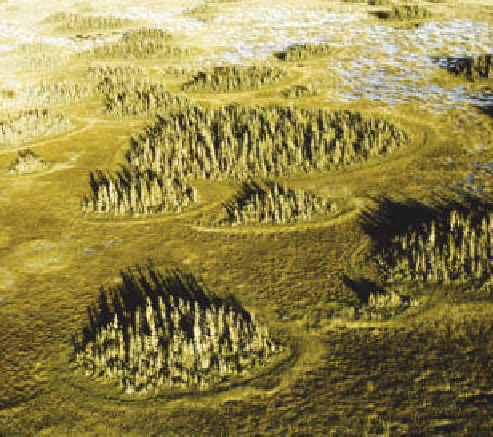Geoscience Reference
In-Depth Information
surface and subsurface peat with a permafrost core. They
are, therefore, features of the Subarctic and the discon-
tinuous permafrost zone, where a greater depth of peat is
able to form.
Peat
or
organic palsas
are restricted to
wetland landscapes, with a mean annual temperature of
-1
C.
Mineral palsas
have a core of mineral soil, usually
silt, and are found under colder climates, with mean
annual temperatures of -4
C, as, for example, in
the Ungava region of northern Quebec (Pissart 1973).
The formation of palsas owes much to the presence of
peat. Surface peat forms an insulating layer which restricts
heat penetration into the permafrost in summer. The
thermal conductivity of unfrozen peat is low, ranging
from 0.0002 cal cm
-1
s
-1
C to -6
C
-1
when dry to 0.00011 when
wet; this is much lower than frozen peat, at 0.0056.
Thus freezing is more effective than thawing, and the
autumn/winter freeze exceeds the summer thaw. Ground
heave caused by the growth of segregation ice lenses raises
the ground level, which in turn allows wind to keep the
depth of snow especially thin; the thinness of the snow
cover in winter thus reinforces the freezing of the ground.
So effective are these processes that in some parts of the
discontinuous permafrost zone the distribution of
permafrost is confined to peatland (
Plate 15.21
).
Inuit people (Eskimos) in Canada apply the word
'pingo' to conical mounds common in the Mackenzie
Delta area of the North West Territories, where, in a
coastal zone 320 km long and 80 km wide, there are more
than 1,500 pingos. The Russian synonym is
bulgunniakh
.
In addition to pingos on land, about 100 submarine
pingos have been discovered in the shallow waters of the
adjoining Beaufort Sea. Pingos range from 3 m to 45 m
in height, and from 30 m to 600 m diameter. Nearly all
pingos are located close to the centre of a depression
which contains a shallow lake or the remains of one. In a
famous field experiment Mackay (1998) drained Illisarvik
Lake, North West Territories, and was rewarded by wide-
spread pingo growth. All pingos in the Mackenzie Delta
have developed on deltaic sands and silts, but, because they
have grown in lake depressions, a layer of organic matter
interbedded with fine-grained lake sediments often covers
them. The cores of the pingos consist of pure ice, or ice
containing bubbles and thin layers of sand.
Pingos are formed by the arching-up of an impervious
sheet of perennially frozen ground by the intrusion from
beneath of water under pressure which subsequently
freezes. The source of the water leads to the recognition
of two distinct types of pingo formation. In
open-system
pingos
a
hydraulic
head of water in a valley bottom
develops in unfrozen layers beneath the permafrost. The
pressure comes from the aquifer with a range in altitude.
They are also referred to as
Greenland type
owing to their
common occurrence in high-relief environments like
Alaska, Greenland, Iceland, Svalbard and Norway. As the
water under pressure approaches the surface it freezes. The
continual supply of water results in a subsurface mass
of ice which domes the surface upwards. They have a
dispersed distribution and are usually at the foot of slopes.
The essential factor is water at depth under a pressure of
at least six atmospheres.
In
closed-system pingos
, also known as
Mackenzie
type
,
hydrostatic
pressure is the trigger (
Plate 15.22
).
The
pressure results from the expulsion of excess pore water
from the freezing of a confined body of saturated soil.
Such conditions exist primarily under drained, shallow
lakes, and all pingos in the Mackenzie Delta are of this
closed-system type (Mackay 1971). Their development
requires the sudden drainage of lakes or, more rarely, the
migration of rivers. These water bodies maintain unfrozen
sediment or
talik
beneath them, but permafrost quickly
forms in the sediments when exposed to the air by the
drainage of the lakes. Also, permafrost invades this
unfrozen zone from the sides. As the water in the lake
sediments freezes, it expands by 9 per cent in volume. If
the water is free to escape, about 9 per cent of the pore
water will be expelled in advance of the freezing front to
relieve the pressure. When permafrost aggrades in the
exposed lake bottom, pore water is expelled upwards,
beneath the lower permafrost surface. The expelled water
eventually freezes, forming the core of the pingo.










































